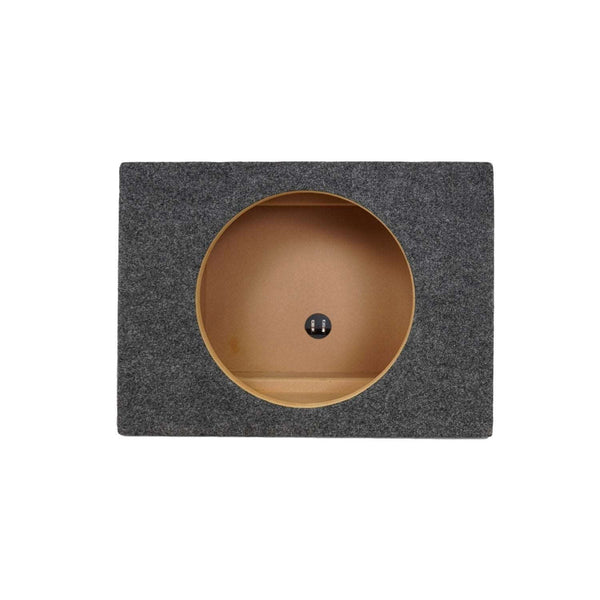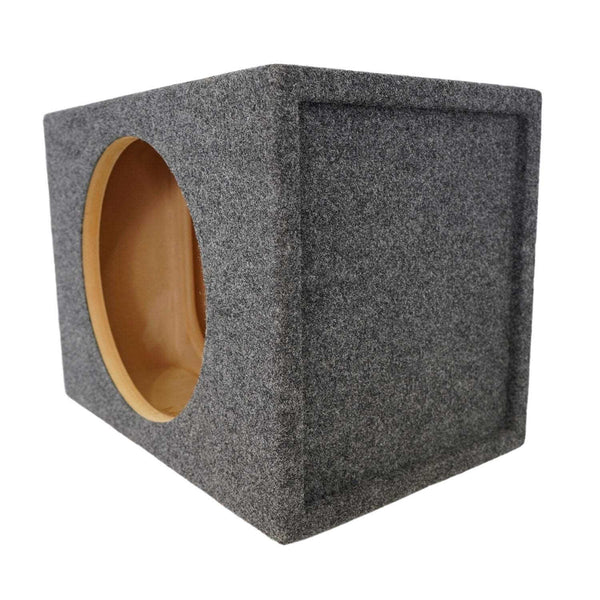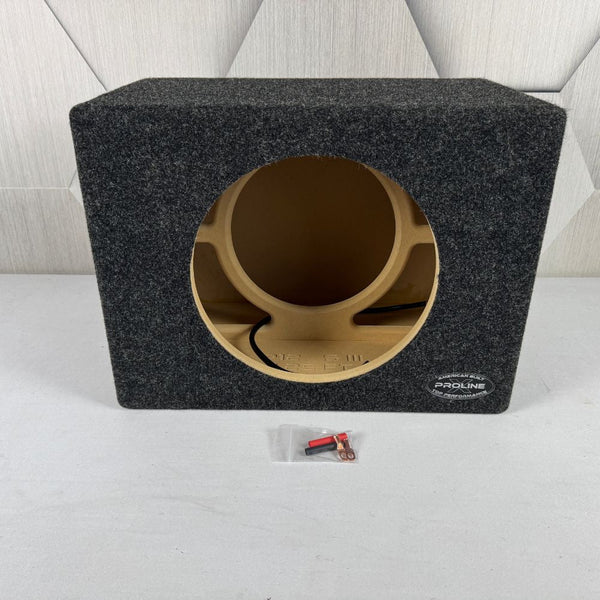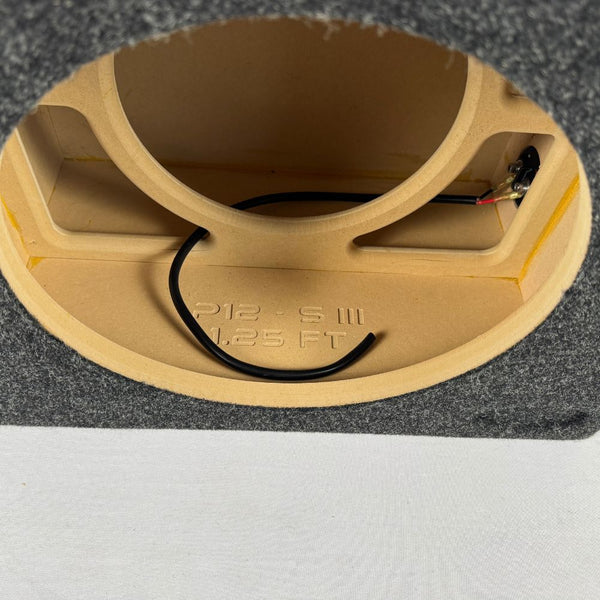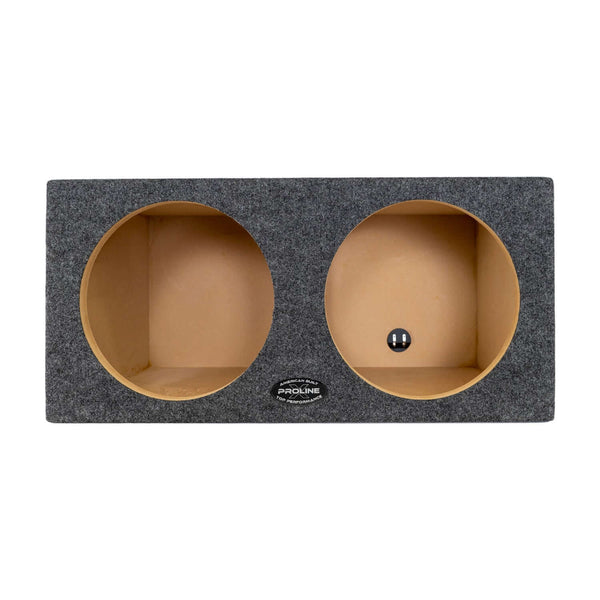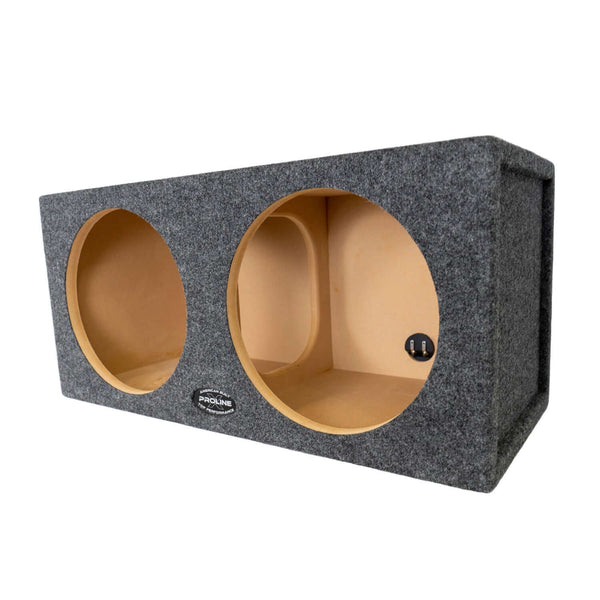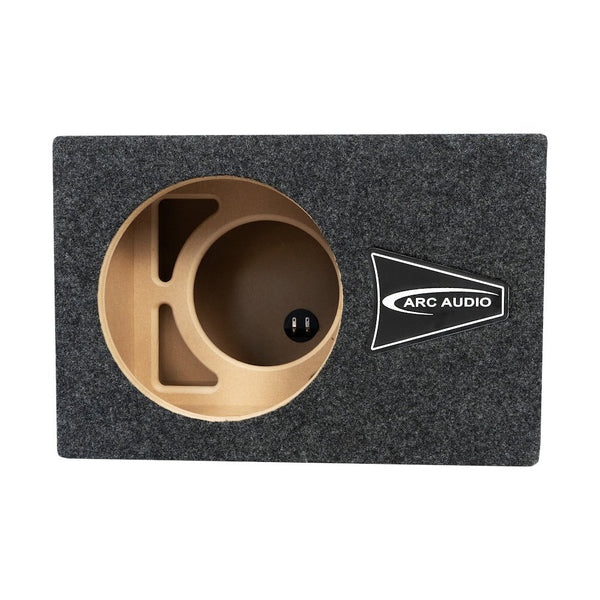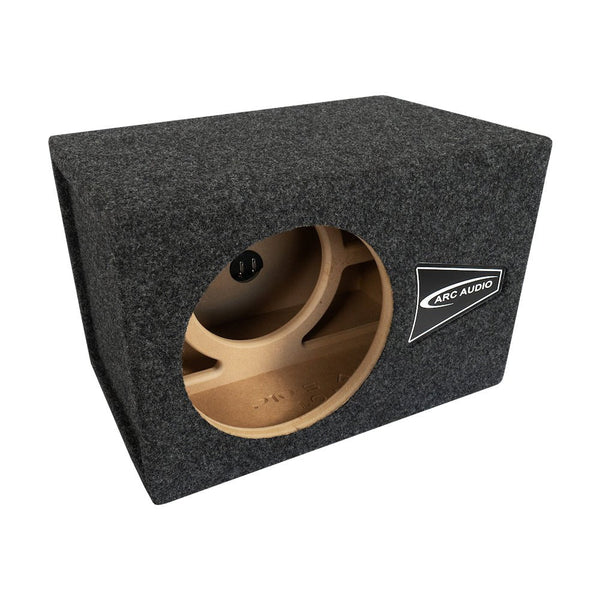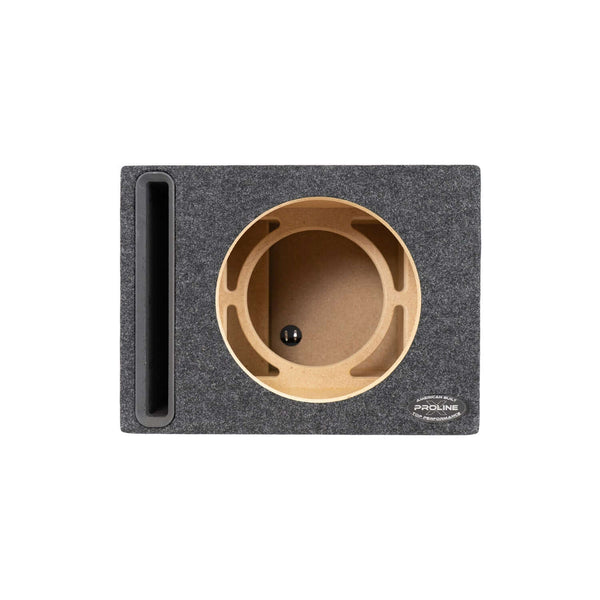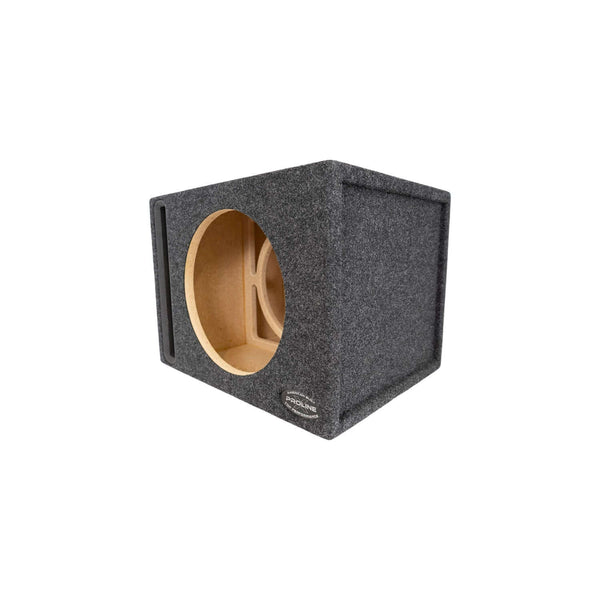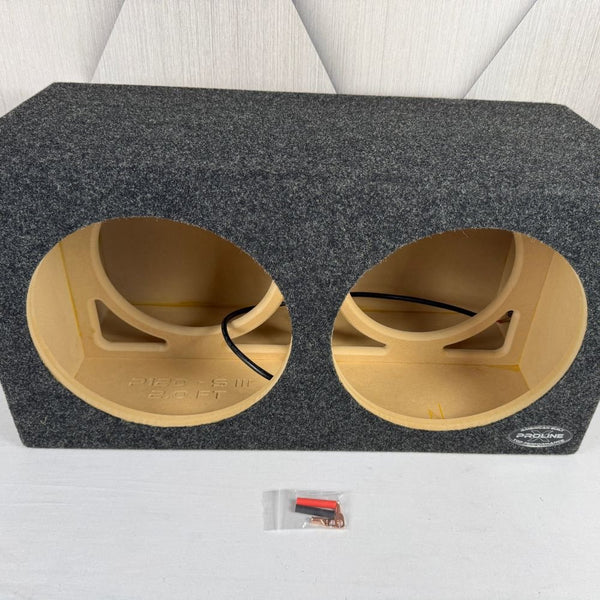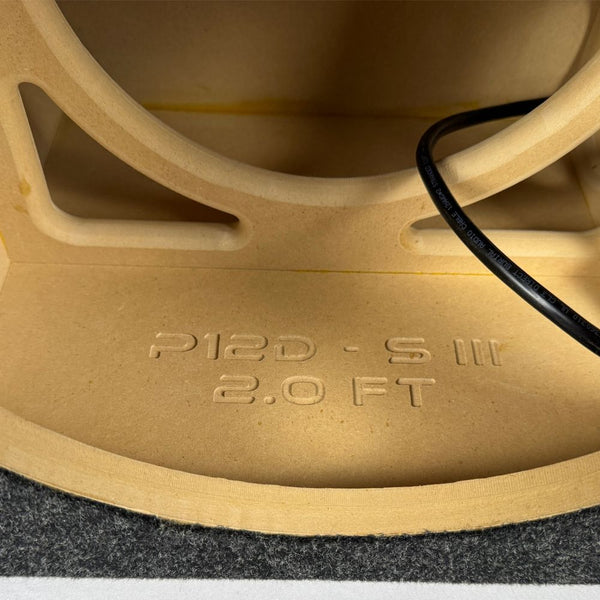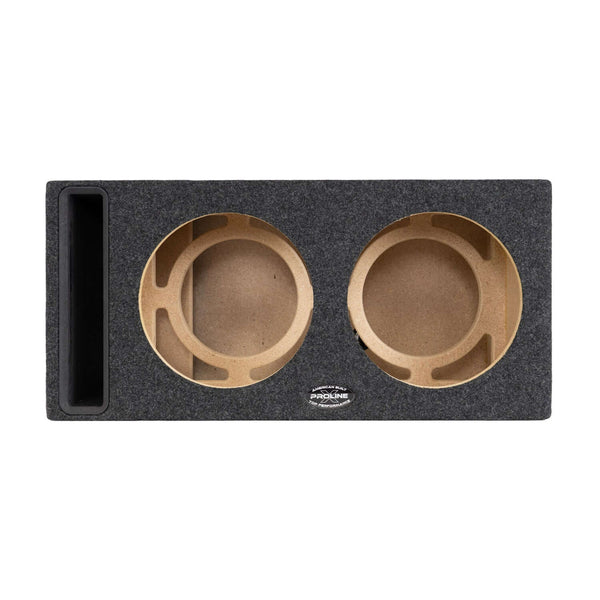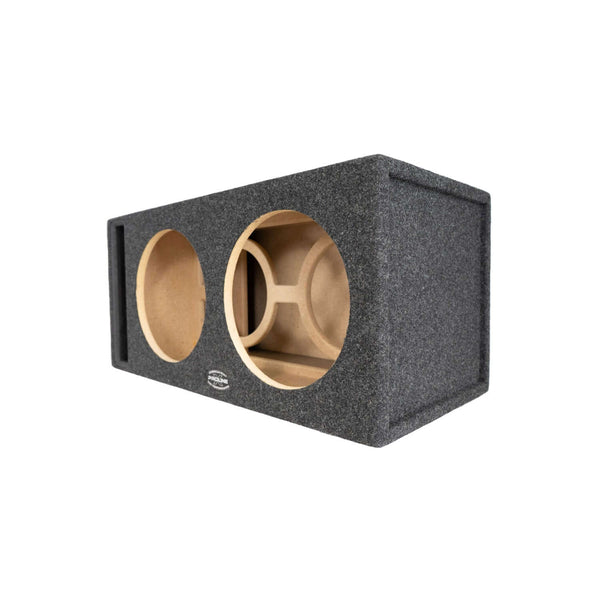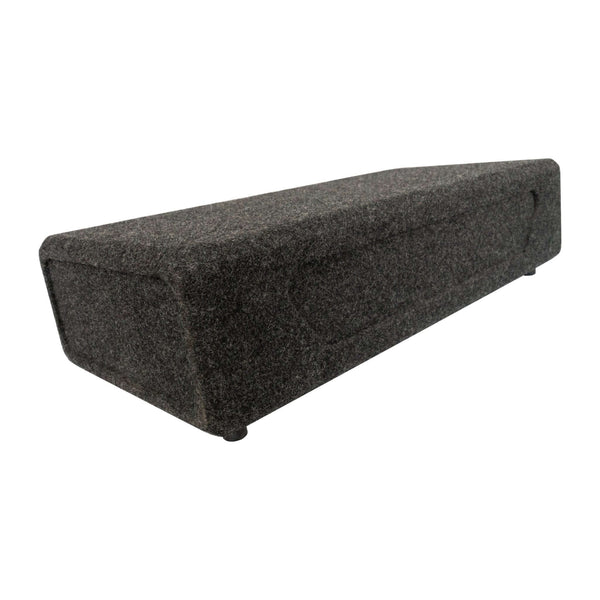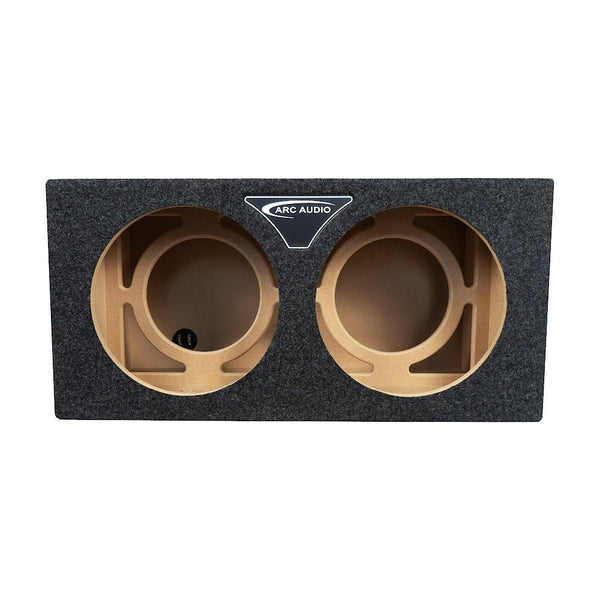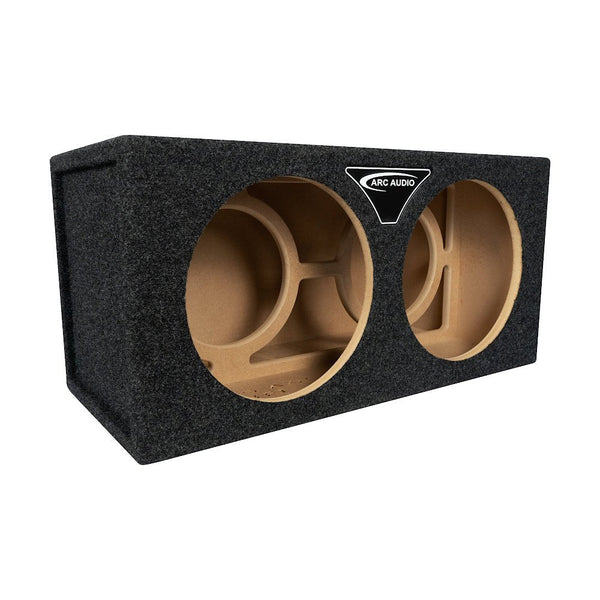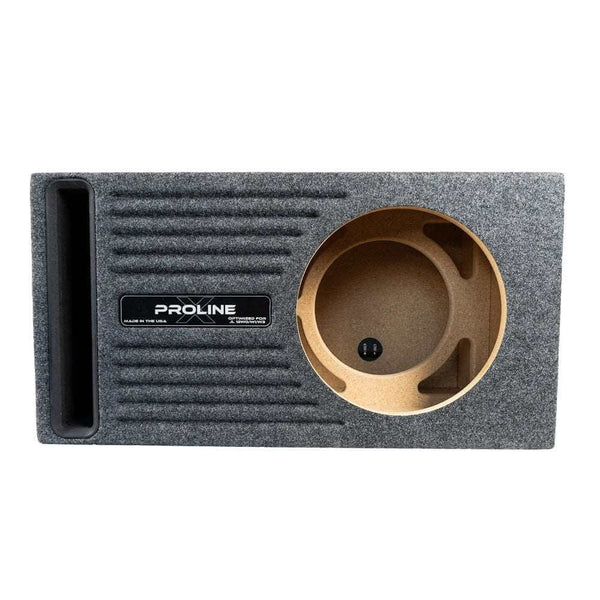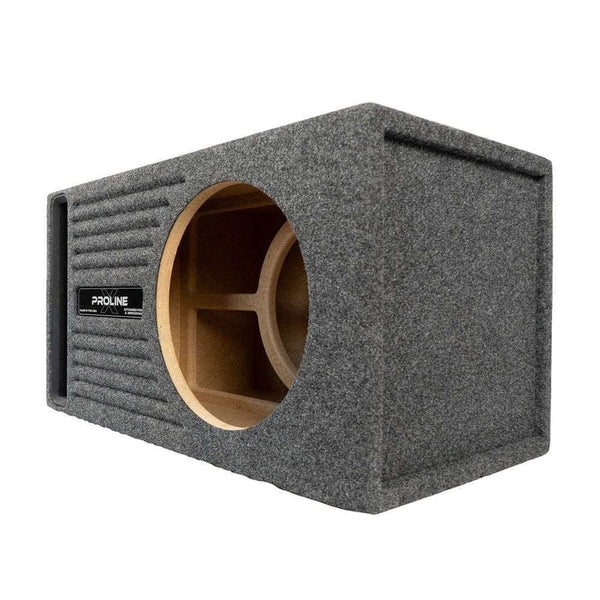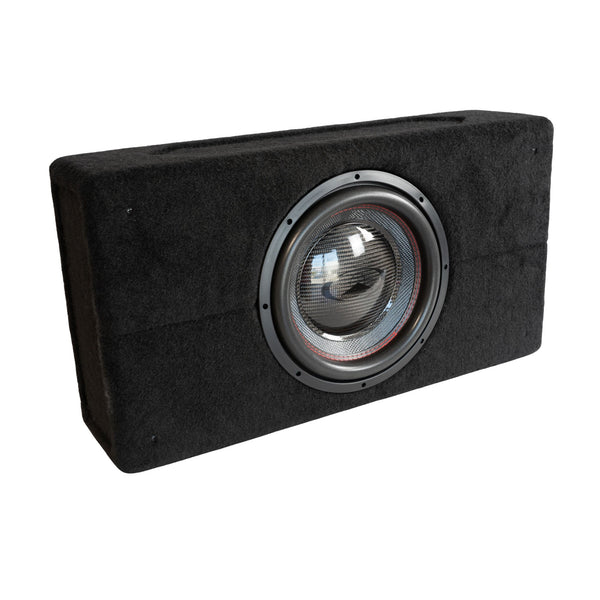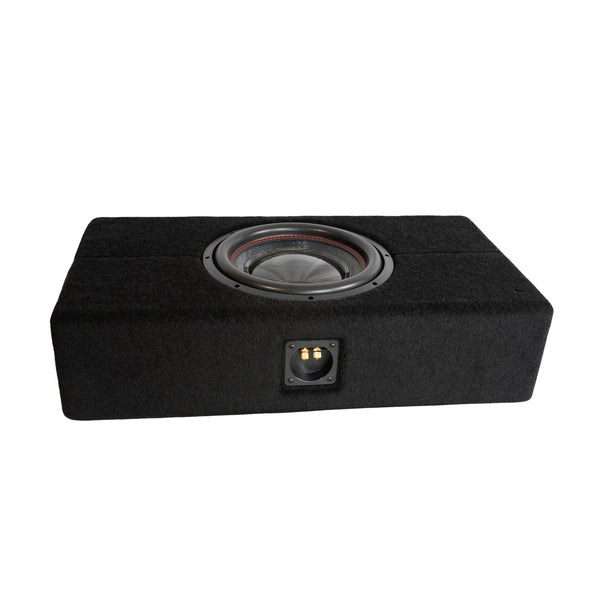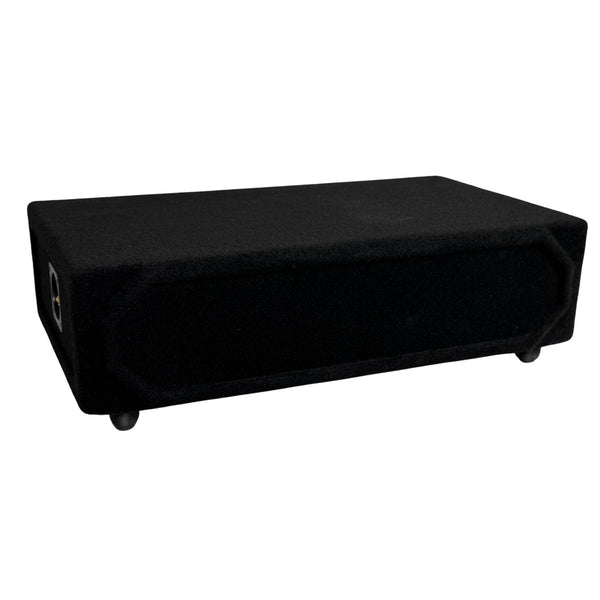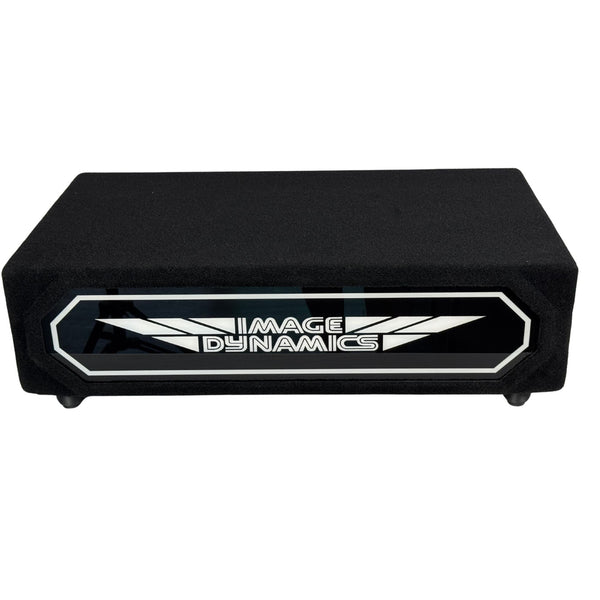12 Inch Subwoofer Boxes
Expertly crafted to deliver deep bass—experience enhanced sound quality with these optimized 12 inch subwoofer boxes..
Looking for a 12 inch subwoofer box that delivers clean, powerful bass? At Audio Intensity, we design and build enclosures that maximize output without sacrificing accuracy. Whether you need a sealed subwoofer box for tight response or a ported subwoofer box for extra volume, our Proline-X series uses CNC precision cuts, premium MDF, and acoustic engineering for consistent results. Every enclosure ships free and comes backed by our 2-year warranty. Explore our full selection below.
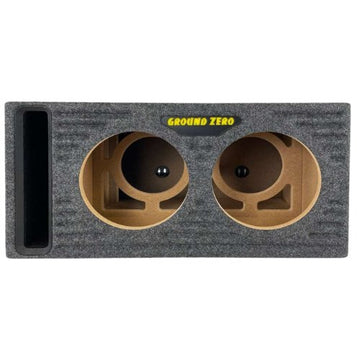
- Audio Intensity
- Collections
- 12 Inch Subwoofer Boxes
Filters
Collections
12 Inch Subwoofer Boxes
Proline X E12-S Sealed Enclosure
Proline X E12-S Sealed Enclosure
Proline X Performance P12-S Sealed Enclosure for 12" Subwoofers
Proline X Performance P12-S Sealed Enclosure for 12" Subwoofers
Proline X E12D-S Sealed Dual Enclosure for 12" Subwoofers
Proline X Performance Optimized Sealed Enclosure for Single 12" Arc Audio Subwoofers
Proline X Performance P12-P Ported Box for 12 inch Subwoofers
Proline X Performance P12D-S Dual 12-inch Sealed Subwoofer Box
Proline X Performance P12D-P Ported Enclosure for Dual 12" Subwoofers
Proline X Downfiring Single 12" Sub Enclosure - Hertz
Proline X Performance Optimized Sealed Enclosure for Dual 12" Arc Audio Subwoofers
Proline X - Performance Optimized Enclosure for JL 12 W0/W1/W3
Audiomobile Encore 12 inch Sealed Down Firing Subwoofer Enclosure
Audiomobile Encore 12 inch Sealed Down Firing Subwoofer Enclosure
Flex Series Down Fire Subwoofer Box - 1 Cubic Foot
Flex Series Down Fire Subwoofer Box - 1 Cubic Foot
- Featured
- Best selling
- Alphabetically, A-Z
- Alphabetically, Z-A
- Price, low to high
- Price, high to low
- Date, old to new
- Date, new to old
The Complete Guide to 12-Inch Subwoofer Boxes: Everything You Need to Know
Twelve-inch subwoofers represent the perfect balance between deep bass extension and punchy response, making them the most popular choice among car audio enthusiasts. A properly designed 12 inch subwoofer box is crucial for unlocking your subwoofer's full potential, providing the optimal acoustic environment for maximum performance and longevity.
At Audio Intensity, we've been crafting precision-engineered subwoofer enclosures for over two decades. Our Proline-X Performance and Professional Series boxes utilize advanced construction techniques including dado joints, threaded inserts, and premium materials to ensure your investment delivers years of powerful, distortion-free bass.
Understanding Subwoofer Enclosure Types
Sealed Enclosures: Precision and Control
Sealed boxes create an airtight environment that acts as an acoustic shock absorber, controlling cone movement for tight, accurate bass reproduction. The trapped air inside provides natural damping, resulting in flat frequency response and excellent transient response.
Key Characteristics:
- Volume Range: 0.75 - 1.5 cubic feet for most 12" subwoofers
- Frequency Response: Flat, extended low-end with gradual roll-off
- Power Requirements: Higher power needed for maximum output
- Best For: Jazz, classical, acoustic music, audiophile applications
Advantages:
- Compact size fits more vehicle configurations
- Superior sound quality and accuracy
- Better power handling capabilities
- Easier to design and build
Disadvantages:
- Lower efficiency requires more amplifier power
- Less bass output at lower frequencies
- Higher cost per decibel of output
Ported Enclosures: Maximum Output
Ported (vented) boxes use a carefully calculated port to reinforce specific frequencies, creating a resonant system that dramatically increases output efficiency. The port redirects rear-wave energy to combine constructively with front-wave output.
Key Characteristics:
- Volume Range: 1.5 - 3.0 cubic feet for typical 12" applications
- Tuning Frequency: 28-45 Hz depending on application
- Port Area: 12-25 square inches per cubic foot of internal volume
- Best For: Hip-hop, EDM, rock, maximum SPL applications
Advantages:
- Higher efficiency and output
- Extended low-frequency response when properly tuned
- Better amplifier utilization
- Enhanced cooling through air movement
Disadvantages:
- Larger size requirements
- More complex design calculations
- Potential for port noise if undersized
- Group delay at tuning frequency
Bandpass Enclosures: Specialized Performance
Bandpass designs combine sealed and ported chambers, with the subwoofer mounted between them. Sound emerges only through the port, creating extremely high output within a narrow frequency band.
Key Characteristics:
- Configuration: Dual-chamber design (sealed + ported)
- Output: 3-6 dB gain within passband
- Frequency Range: Typically 40-80 Hz passband
- Best For: Competition SPL, specific musical genres
Advantages:
- Maximum output within tuned range
- Natural filtering eliminates frequencies outside passband
- Dramatic impact for specific applications
Disadvantages:
- Limited frequency range
- Complex design requirements
- Larger enclosure size
- Difficult to modify or retune
Technical Specifications Guide
Volume Calculations and Requirements
Proper internal volume is critical for optimal subwoofer performance. Too small, and you'll lose low-end extension; too large, and you'll sacrifice control and efficiency.
General Guidelines for 12" Subwoofers:
Enclosure TypeVolume RangeTypical ApplicationSealed Small0.75 - 1.0 ft³SQ-focused, limited spaceSealed Optimal1.0 - 1.5 ft³Balanced performancePorted Compact1.5 - 2.0 ft³Space-conscious SPLPorted Optimal2.0 - 3.0 ft³Maximum performanceBandpass2.5 - 4.0 ft³Competition/specialized
Volume Calculation Formula: Internal Volume = (Height - Material Thickness) × (Width - Material Thickness) × (Depth - Material Thickness) ÷ 1728
Remember to subtract driver displacement, bracing, and port volumes from gross internal volume.
Port Tuning and Design
Port tuning frequency (Fb) determines where the enclosure provides maximum output and efficiency. This critical parameter affects both sound quality and subwoofer protection.
Tuning Frequency Guidelines:
For Sound Quality (SQ):
- 28-32 Hz: Maximum low-end extension, natural sound
- 32-35 Hz: Balanced extension and impact
- 35-38 Hz: Slight emphasis on midbass punch
For Sound Pressure Level (SPL):
- 38-42 Hz: Good balance of extension and efficiency
- 42-50 Hz: Maximum efficiency, competition tuning
- 50+ Hz: Specialized applications, sacrifices extension
Port Area Calculations:
- Minimum: 12 square inches per cubic foot
- Optimal: 16-20 square inches per cubic foot
- Maximum: 25+ square inches per cubic foot (for very high power)
Port Length Formula (Slot Port): Length = (23,562.5 × Port Area) ÷ (Fb² × Vb) - (0.732 × √Port Area)
Where:
- Port Area = in square inches
- Fb = tuning frequency in Hz
- Vb = box volume in cubic feet
Power Handling and Amplifier Matching
Proper power matching ensures optimal performance while protecting your investment. Consider both thermal and mechanical limitations.
RMS Power Guidelines:
- Sealed: Use 75-150% of subwoofer's RMS rating
- Ported: Use 50-125% of subwoofer's RMS rating
- Bandpass: Use 75-100% of subwoofer's RMS rating
Impedance Considerations:
- Single 4-ohm: Most versatile for amplifier matching
- Dual 2-ohm: Flexibility for series (4Ω) or parallel (1Ω) wiring
- Dual 4-ohm: Options for 2-ohm or 8-ohm final impedance
Complete Buying Guide: Choosing Your Perfect 12-Inch Box
Step 1: Assess Your Space
Trunk Applications:
- Compact Cars: Maximum 24" × 15" × 12" typically
- Mid-size Sedans: Up to 30" × 18" × 14" available
- Full-size Vehicles: 36" × 20" × 16" or larger possible
Hatchback/SUV Considerations:
- Behind Rear Seats: Priority on width and height over depth
- Spare Tire Wells: Custom solutions for maximum space utilization
- Cargo Area: Balance between storage and audio performance
Truck Applications:
- Crew Cab Behind Seats: Typically 32" × 12" × 14" maximum
- Extended Cab: May require custom angled designs
- Under-Seat: Specialized low-profile enclosures
Step 2: Define Your Sound Goals
Sound Quality (SQ) Priority:
- Choose sealed or small ported designs
- Focus on brands known for accuracy
- Consider multiple smaller enclosures vs. single large
- Target tuning frequencies below 35 Hz
Sound Pressure Level (SPL) Priority:
- Large ported or bandpass designs
- High-efficiency subwoofer selection
- Tuning frequencies 38-45 Hz
- Maximum port area within space constraints
Daily Driver Balance:
- Moderate-sized ported enclosures
- Tuning around 32-35 Hz
- Quality construction for longevity
- Reasonable space consumption
Step 3: Match Your Musical Preferences
Electronic/Hip-Hop/EDM:
- Ported boxes tuned 32-38 Hz
- Emphasis on extension and impact
- Higher power handling requirements
- Consider dual-chamber designs
Rock/Metal:
- Sealed boxes for tightness
- Quick transient response priority
- Moderate power requirements
- Focus on 40-80 Hz range
Classical/Jazz/Acoustic:
- Sealed enclosures strongly preferred
- Flat frequency response critical
- Quality over quantity approach
- Integration with full-range speakers
Mixed Listening:
- Compact ported design tuned ~35 Hz
- Balanced approach to all parameters
- Versatile amplifier matching
- Quality construction materials
Step 4: Vehicle Integration Considerations
Electrical System:
- Stock Alternator: Limit to 500-750W RMS total
- Upgraded Charging: 1000W+ systems possible
- Battery Upgrades: Often necessary for high-power systems
- Wiring Gauge: 4 AWG minimum for 500W+, 1/0 AWG for 1000W+
Installation Complexity:
- Basic: Pre-built boxes with simple connections
- Intermediate: Custom sizing, basic modifications
- Advanced: Complete custom builds, complex installations
Installation and Placement Guide
Optimal Positioning Strategies
Trunk Installations:
Rear-Facing (Firing Toward Trunk):
- Advantages: Maximum coupling with trunk space, highest SPL
- Best For: SPL-focused systems, maximum output
- Considerations: May sound "distant" in cabin
Forward-Facing (Firing Toward Cabin):
- Advantages: More immediate sound, better integration
- Best For: Sound quality applications, balanced response
- Considerations: Slightly lower maximum output
Upward-Facing:
- Advantages: Even distribution, space-efficient
- Best For: Hatchbacks, SUVs with rear access
- Considerations: Requires adequate clearance above
Downward-Facing:
- Advantages: Floor coupling, unique aesthetic
- Best For: Show vehicles, specialized applications
- Considerations: Proper clearance and ventilation critical
Professional Installation Tips
Securing Your Enclosure:
- Use minimum 1/4" bolts through vehicle mounting points
- Distribute load across multiple attachment points
- Consider removable installations for versatility
- Never rely solely on weight for security
Wiring Best Practices:
- Route power cables away from signal cables
- Use appropriate gauge wire for amplifier power
- Secure all connections with quality terminals
- Include inline fusing within 18" of battery
Acoustic Considerations:
- Leave 2-3" clearance around ports
- Avoid placing ports directly against surfaces
- Consider cabin acoustics and listening position
- Test multiple positions before final installation
Common Installation Mistakes to Avoid
- Insufficient Electrical System: Undersized alternator or wiring
- Poor Mounting: Inadequate securing leads to rattles and damage
- Port Blockage: Restricting airflow reduces performance and reliability
- Impedance Mismatch: Wrong load impedance reduces amplifier output
- Phase Issues: Incorrect polarity causes cancellation effects
- Inadequate Clearance: Risk of damage during normal vehicle use
Advanced Topics and Optimization
Enclosure Alignment Theory
Understanding alignment types helps optimize performance for specific applications:
Sealed Alignments:
- Qtc = 0.5: Maximum flatness, audiophile preference
- Qtc = 0.707: Optimal balance, most common choice
- Qtc = 1.0: Slight midbass emphasis, warmer sound
Ported Alignments:
- SBB4 (Super Boom Box): Maximum efficiency alignment
- QB3: Good balance of extension and control
- C4: Extended low-frequency response
Advanced Design Considerations
Bracing and Damping:
- Internal cross-bracing every 12-16 inches
- 1-2 pounds of polyfill per cubic foot in sealed boxes
- Acoustic foam on internal surfaces reduces standing waves
- Avoid over-damping in ported applications
Material Selection:
- MDF: Standard choice, easy to work with, good acoustics
- Birch Plywood: Superior strength, premium option
- Composite Materials: Specialized applications, highest performance
- Hardware: Stainless steel fasteners, quality terminals
Thermal Management:
- Adequate ventilation around driver basket
- Consider cooling fans for extreme SPL applications
- Monitor voice coil temperatures during extended use
- Quality amplifier matching prevents thermal stress
Measurement and Testing
Essential Measurements:
- Frequency Response: In-vehicle testing with RTA
- Impedance Sweep: Verify tuning frequency accuracy
- Distortion Analysis: Ensure clean operation at target levels
- Phase Response: Integration with full-range speakers
Testing Equipment:
- Real-Time Analyzer (RTA) or smartphone apps
- Sound Pressure Level (SPL) meter
- Multimeter for electrical verification
- Oscilloscope for advanced analysis
Troubleshooting Common Issues
Bass Response Problems
Insufficient Low-End Extension:
- Check enclosure volume - may be too small
- Verify tuning frequency - might be too high
- Examine amplifier power - could be inadequate
- Review placement - boundary coupling affects response
Boomy or Muddy Bass:
- Enclosure may be too large for application
- Poor damping or excessive port noise
- Room acoustics creating standing waves
- Integration issues with main speakers
Lack of Impact:
- Insufficient amplifier power for application
- Wrong enclosure type for musical preference
- Poor electrical connections reducing power transfer
- Driver may not match enclosure specifications
Physical and Electrical Issues
Rattles and Vibrations:
- Loose mounting hardware
- Panel resonances from insufficient bracing
- Objects in trunk vibrating sympathetically
- Worn suspension components
Thermal Protection Activation:
- Impedance too low for amplifier
- Inadequate ventilation around equipment
- Gain settings too aggressive
- Electrical system voltage dropping under load
Port Noise Issues:
- Port area too small for power level
- Sharp port edges creating turbulence
- Port length incorrect for tuning frequency
- Debris obstructing port opening
Maintenance and Longevity
Regular Maintenance Schedule
Monthly Checks:
- Visual inspection of all connections
- Verify mounting hardware tightness
- Clean dust from amplifier heat sinks
- Check for physical damage or wear
Quarterly Maintenance:
- Deep clean enclosure interior
- Inspect driver surrounds and spider
- Verify electrical connections with multimeter
- Update system tuning if needed
Annual Service:
- Complete system performance measurement
- Replace worn hardware or terminals
- Consider upgrades based on usage patterns
- Professional inspection for high-use systems
Protecting Your Investment
Operating Guidelines:
- Avoid sustained maximum output levels
- Allow cooling periods during extended use
- Monitor amplifier temperature regularly
- Use appropriate gain structure
Environmental Protection:
- Avoid extreme temperature exposure
- Protect from moisture and humidity
- Secure against theft with quality installation
- Consider insurance for high-value systems
Product Specifications and Compatibility
Audio Intensity Professional Series
Our flagship Professional Series 12-inch boxes represent the pinnacle of subwoofer enclosure design, featuring:
Construction Features:
- 3/4" premium MDF with 1" front baffle
- Dado joint construction for maximum strength
- Threaded brass inserts for secure driver mounting
- Internal cross-bracing every 12 inches
- Professional-grade carpet covering
- Dual binding post terminals
Available Configurations:
Model AI-PS12-S (Sealed):
- Internal Volume: 1.25 cubic feet
- Recommended Power: 300-600W RMS
- External Dimensions: 18" × 14" × 12"
- Compatible Drivers: Most 12" SQ-focused subwoofers
- Applications: Audiophile systems, limited space installations
Model AI-PS12-P (Ported):
- Internal Volume: 2.0 cubic feet
- Tuning Frequency: 32 Hz
- Port Configuration: Slot port, 20 square inches
- Recommended Power: 250-500W RMS
- External Dimensions: 24" × 16" × 14"
- Compatible Drivers: Most 12" SPL/balanced subwoofers
Proline-X Performance Series
Our Proline-X series offers professional-grade performance at an accessible price point:
Construction Features:
- 5/8" MDF construction with reinforced corners
- Rabbet joint assembly with adhesive and fasteners
- Recessed mounting hardware
- Quality carpet covering with protective corners
- Spring-loaded terminals
Popular Models:
Model AI-PX12-C (Compact Ported):
- Internal Volume: 1.75 cubic feet
- Tuning Frequency: 35 Hz
- External Dimensions: 22" × 14" × 13"
- Weight: 28 lbs
- Price Point: Mid-range performance value
Model AI-PX12-B (Bandpass):
- Total Volume: 3.2 cubic feet (0.8 sealed, 2.4 ported)
- Tuning Frequency: 42 Hz
- Output Gain: +4 dB within passband
- External Dimensions: 28" × 16" × 15"
- Applications: SPL competition, maximum impact
Subwoofer Compatibility Guide
Premium Compatibility:
- Alpine R Series: Excellent match for all configurations
- Image Dynamics IDMAX: Optimized sealed and ported options available
- JL Audio W Series: Professional Series recommended
- Rockford Fosgate Power Series: Proline-X excellent value match
Performance Matching Matrix:
Subwoofer TypeRecommended BoxOptimal TuningPower RangeSQ-FocusedSealed/Small Ported28-32 Hz300-600WBalanced PerformanceMedium Ported32-35 Hz400-800WSPL-OrientedLarge Ported/Bandpass38-45 Hz500-1200WCompetitionCustom Bandpass40-50 Hz800-2000W+
Size and Fitment Reference
Vehicle-Specific Recommendations
Compact Cars (Civic, Corolla, Focus):
- Maximum Practical Size: 20" × 12" × 10"
- Recommended Configuration: Sealed or small ported
- Typical Placement: Trunk, behind rear seat
- Power Limitations: 300-500W (electrical system constraints)
Mid-Size Sedans (Camry, Accord, Altima):
- Maximum Practical Size: 28" × 16" × 12"
- Recommended Configuration: Medium ported
- Typical Placement: Trunk corner or center
- Power Capabilities: 500-800W with minor electrical upgrades
Full-Size Vehicles (Impala, Charger, Crown Vic):
- Maximum Practical Size: 32" × 18" × 14"
- Recommended Configuration: Large ported or bandpass
- Typical Placement: Trunk with ample clearance
- Power Capabilities: 800W+ with proper electrical system
SUVs and Hatchbacks (CR-V, RAV4, Wrangler):
- Variable sizing based on configuration
- Consider cargo space requirements
- Down-firing options popular
- Integration with factory systems important
Pickup Trucks:
- Regular Cab: Limited options, under-seat priority
- Extended Cab: Behind-seat installations
- Crew Cab: Full-size options available
- Weather protection considerations important
Custom Sizing Guidelines
When space constraints require custom dimensions:
- Maintain Volume: Adjust proportions while preserving internal volume
- Avoid Extreme Ratios: Keep L:W:H ratios between 1.2:1 and 3:1
- Port Considerations: Maintain minimum port area requirements
- Bracing Requirements: Add bracing for panels over 16" unsupported
- Access Needs: Consider driver replacement and maintenance
Frequently Asked Questions
Technical Questions
Q: What's the difference between gross and net internal volume? A: Gross volume is the raw internal space calculation, while net volume subtracts driver displacement, bracing, ports, and other internal components. Always use net volume for tuning calculations.
Q: Can I use a ported box smaller than recommended? A: Using a smaller ported enclosure will raise the tuning frequency and may reduce low-end extension. It's better to use a properly-sized sealed box than an undersized ported enclosure.
Q: How do I know if my port is too small? A: Port noise, reduced output, and potential driver damage from excessive air velocity are signs of undersized ports. Minimum 12 square inches per cubic foot is essential.
Q: What happens if I overpower my subwoofer? A: Thermal damage to the voice coil is the primary risk, along with potential mechanical damage from over-excursion. Use proper gain structure and monitor amplifier output.
Installation Questions
Q: Should I use polyfill in my ported box? A: Generally no - polyfill in ported boxes can affect tuning and port performance. It's primarily beneficial in sealed enclosures for apparent volume expansion.
Q: Can I mount my box upside down? A: Physical orientation doesn't affect acoustic performance, but ensure proper ventilation around the driver and amplifier, and secure mounting in all orientations.
Q: How much clearance do I need around my box? A: Leave 2-3 inches around ports for proper airflow, and ensure adequate ventilation around the driver basket for cooling.
Performance Questions
Q: Why does my bass sound different at different volumes? A: This is normal - both driver behavior and cabin acoustics change with output level. Room correction or EQ can help maintain consistent response.
Q: Should I add a second subwoofer? A: Adding a second identical subwoofer provides 3-6 dB additional output and can improve in-cabin response uniformity, but requires double the amplifier power.
Q: How do I integrate my subwoofer with factory speakers? A: Use a bass manager or crossover to set appropriate frequency ranges, typically 80-120 Hz crossover point, and adjust phase for optimal integration.
Related Products and Upgrades
Complementary Enclosures
For different applications or multi-sub systems, consider our complete range:
- 10-inch subwoofer boxes: Compact installations, tight spaces
- 15-inch subwoofer boxes: Maximum output, full-size applications
- Custom enclosures: Vehicle-specific solutions available
System Components
Complete your bass system with quality components:
- Premium subwoofers: Matched drivers for optimal performance
- High-performance amplifiers: Clean power delivery
- Professional installation accessories: Wiring, fusing, terminals
- Sound dampening materials: Reduce vibrations and improve acoustics
Upgrade Paths
Entry Level → Performance:
- Upgrade from basic sealed to quality ported design
- Add proper amplifier for improved headroom
- Include sound treatment for cleaner response
Performance → Competition:
- Move to bandpass or custom enclosures
- Upgrade electrical system for high power
- Add measurement equipment for precision tuning
Conclusion: Making the Right Choice
Selecting the perfect 12-inch subwoofer box involves balancing multiple factors: available space, musical preferences, power requirements, and budget considerations. Whether you choose a compact sealed enclosure for audiophile accuracy or a large ported design for maximum impact, proper selection and installation will reward you with years of exceptional bass performance.
At Audio Intensity, our two decades of experience in designing and manufacturing subwoofer enclosures means you're getting proven performance and reliability. Every box is built to exacting standards using premium materials and time-tested construction techniques.
Ready to transform your mobile audio experience? Browse our complete selection of 12-inch subwoofer boxes and discover why Audio Intensity remains the choice of discerning enthusiasts and professionals worldwide.
For personalized recommendations based on your specific vehicle and preferences, contact our technical support team. We're here to help you achieve the bass performance you're looking for.
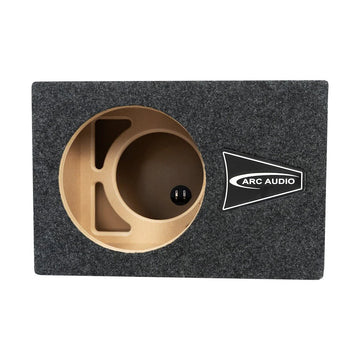
12 Inch Subwoofer Boxes
Frequently Asked Questions
What’s the difference between sealed and ported 12 inch subwoofer boxes?
Sealed boxes offer tighter, more accurate bass response, while ported boxes provide louder output and deeper extension. The best choice depends on your music preference and available space.
Which subwoofers fit these 12 inch boxes?
Our 12 inch enclosures fit most major brands including Alpine, JL Audio, Image Dynamics, Kicker, and Audiomobile. Each product page lists mounting depth and cutout specs to confirm compatibility.
Do these boxes work in trucks and SUVs?
Yes, we offer universal and vehicle-specific 12 inch enclosures. Down-firing and low-profile options are available for tighter spaces, such as under seats.
Do the boxes come pre-loaded with subwoofers?
- We sell both empty enclosures and loaded subwoofer boxes where the subwoofer is pre-installed and wired. Check each product listing for details.
Product Spotlight
No video available for this collection.

